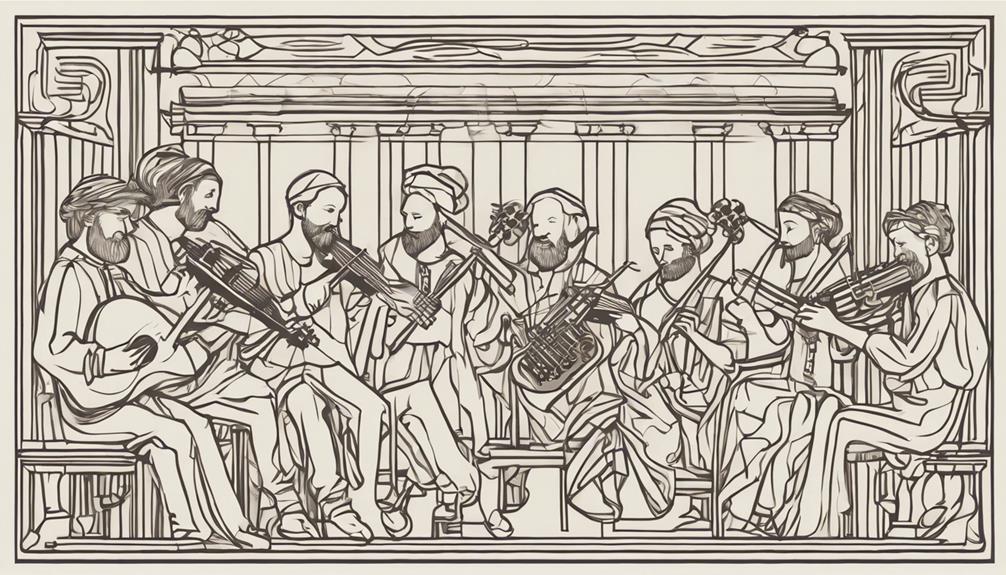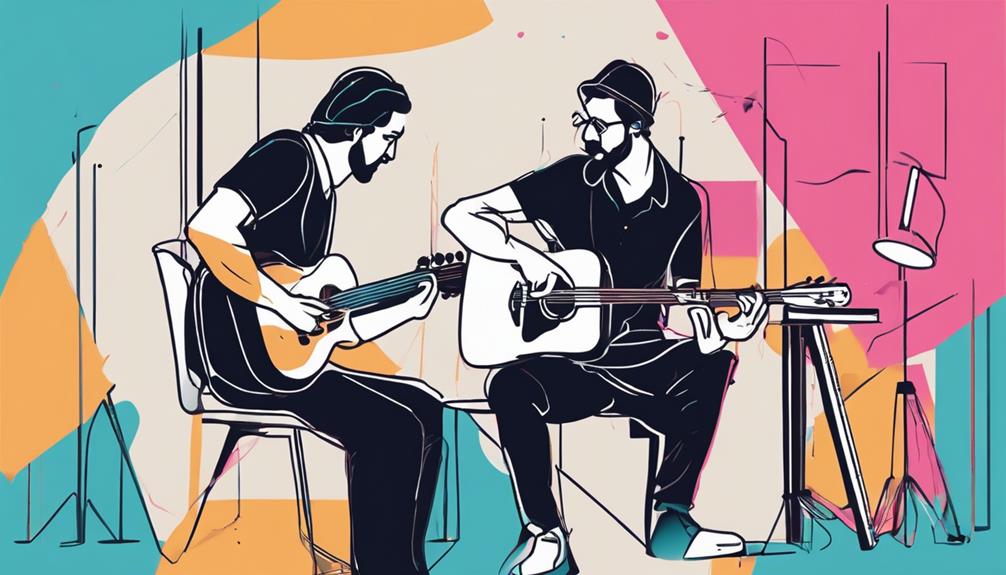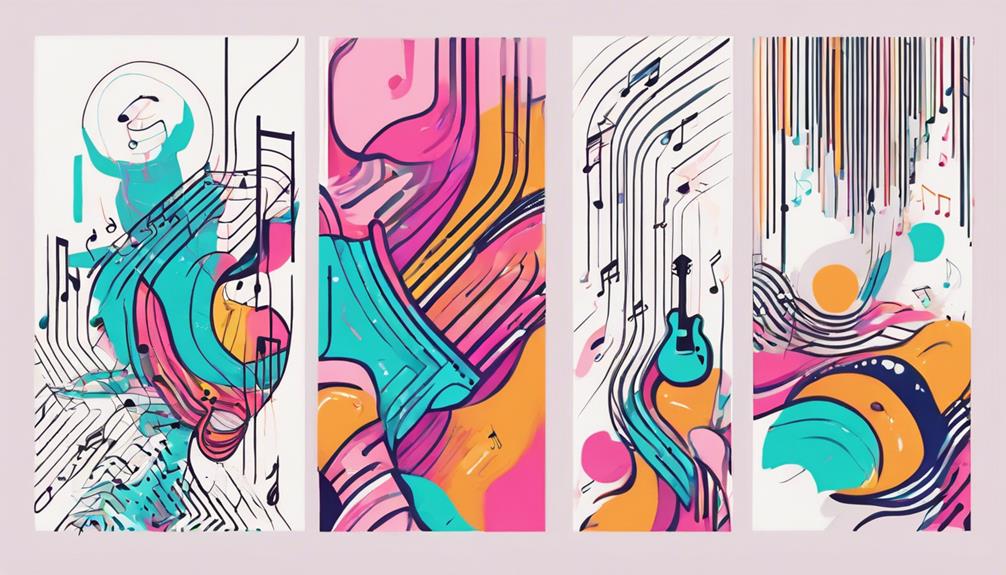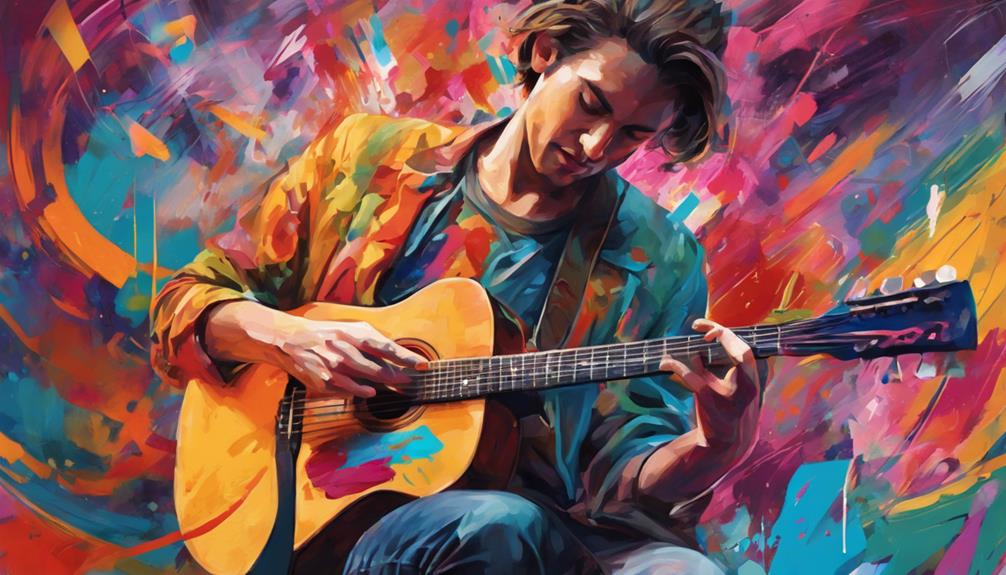The interplay between music and art has long fascinated scholars and creatives alike, unveiling a complex web of influence and inspiration that transcends traditional boundaries. As artists delve into the realms where sound and visuals converge, a myriad of questions arise: How does a symphony translate into brush strokes? Can a painting evoke the same emotions as a sonata? The intricate relationship between these two forms of expression begs for exploration, offering a gateway to a deeper understanding of the artistic process and the human experience itself.
Key Takeaways
- Impressionist painters translated music harmonies into visual art.
- Art visually captures emotions akin to music through color and mark-making.
- Artists and musicians mutually inspire diverse forms of expression.
- Visual artists translate melodies and rhythms into dynamic visual masterpieces.
Historical Interplay of Music and Art

During the 19th century, a notable historical interplay between music and art emerged, as evidenced by the influences of composers such as Maurice Ravel and Claude Debussy on Impressionist painters. This connection between music and art manifested in the visual works of artists who sought to capture the essence of music through painting. Impressionist painters, inspired by the harmonies and rhythms in compositions by Ravel and Debussy, translated these auditory experiences into visual representations on canvas. The interplay between music and art was not limited to Impressionism; artists across different movements and styles also found inspiration in music. For instance, abstract artists like Paul Klee and Wassily Kandinsky transformed music into visual art by using abstract shapes and vibrant colors to evoke the emotions and sensations elicited by musical compositions. This historical relationship between music and art showcases the dynamic ways in which artists have drawn upon musical elements to enrich and inform their visual creations.
Emotional Responses: Music Vs Art
The emotional impact of music and art differs in the way they elicit and convey feelings through distinct sensory modalities. Music affects individuals by stimulating auditory receptors, invoking a direct emotional response through sound frequencies, rhythms, and lyrics. Listening to different musical genres can evoke a range of emotions, from joy and excitement to sadness and nostalgia. On the other hand, art, through mark-making and color, visually captures emotions and translates them into tangible forms that can be interpreted by the viewer. The Connection Between Art and music lies in the ability of art to visually represent the emotional content of music, creating a harmonious interplay between the two forms of expression. While both music and art have the power to trigger deep emotional reactions, the emotional depth of art can be influenced by the mood and themes of the music being interpreted. Emotions depicted in art and music are easily identifiable and resonate with individuals on a personal level, forming a profound emotional connection between the audience and the artwork or musical piece.
Mutual Inspiration and Creation Process

The relationship between music and art is characterized by a creative exchange that transcends disciplinary boundaries. Artists and musicians mutually inspire each other, influencing the creation process through a dynamic interchange of ideas and emotions. This cross-disciplinary influence fosters a rich environment where diverse forms of expression converge to produce innovative and interconnected artistic outcomes.
Creative Exchange
Indisputably intertwined, the realms of music and art engage in a dynamic creative exchange, mutually inspiring and shaping each other's expressive endeavors. Artists draw inspiration from the emotional influence of music, translating melodies and rhythms into brushstrokes and color palettes during their creative process. Conversely, musicians often find themselves deeply moved by visual art, using the evocative power of paintings and sculptures to infuse their compositions with heightened emotions. This reciprocal relationship results in the creation of interdisciplinary works where harmonies, rhythms, and emotions converge to produce unique sensory experiences for audiences. Collaborations between musicians and visual artists exemplify how the shared elements of music and art merge, showcasing the profound connection and mutual influence between these expressive forms.
Cross-disciplinary Influence
Interwoven in a dynamic exchange of creativity, music and art mutually inspire and shape each other's expressive endeavors, embodying a profound cross-disciplinary influence.
- Musicians frequently collaborate with visual artists, producing album covers, music videos, and live performances that blur the lines between auditory and visual experiences.
- Visual artists derive inspiration from music genres, lyrics, and emotional nuances, translating these elements into captivating artworks that reflect the essence of the music.
- The symbiotic creation process involves a deep interplay of ideas and emotions between musicians and visual artists, culminating in innovative outcomes that challenge traditional artistic boundaries and offer audiences a rich, multi-sensory experience.
Artists Bridging Music and Visual Art
Artistic endeavors that intertwine music and visual art showcase a profound fusion of sensory experiences, exemplified by the works of Raosaheb Gurav, Jayshree P Malimath, and Arti Vohra. Raosaheb Gurav's artwork 'Dhangar' delves into the aesthetics of drumbeats and rhythm, seamlessly blending musical elements with visual art. Jayshree P Malimath's painting 'Musician-03' captures the essence of a musician engrossed in their craft, bridging the gap between sound and sight. Similarly, Arti Vohra's piece 'Cosmic Musician' symbolizes the spiritual connection to music through the portrayal of Lord Krishna's devotion to the flute. These artists adeptly use color, composition, and subject matter to evoke the emotions and sensations associated with music in their visual creations, highlighting the deep interplay between music and painting.
| Artist | Artwork | Theme |
|---|---|---|
| Raosaheb Gurav | 'Dhangar' | Drumbeats and rhythm |
| Jayshree P Malimath | 'Musician-03' | Immersion in music |
| Arti Vohra | 'Cosmic Musician' | Spiritual connection to music |
Depicting Sound Through Visual Mediums

Utilizing visual mediums, artists adeptly capture the intangible essence of sound, translating music into tangible forms that resonate with viewers.
- Visual artists: Visual artists often translate the emotions and rhythms of music into visual masterpieces, creating a bridge between auditory and visual senses.
- Relationship Between Music and Album Covers: Some visual artworks, such as paintings or illustrations, serve as album covers, visually representing the style and genre of the music contained within. This visual representation can give listeners a glimpse into the mood and themes of the music before they even hear a single note.
- Evoke an Emotional Response: Music has the power to evoke strong emotions, and visual representations of music can further enhance this effect. Artists inspired by music may create pieces that aim to evoke specific emotions in viewers, deepening the connection between the auditory and visual arts.
In this dynamic interplay between music and visual art, artists create a fusion of sensory experiences that enrich and expand the ways in which audiences can engage with and interpret music.
Exploring Color, Rhythm, and Harmony
The interplay between color, rhythm, and harmony in music and art is a fascinating subject of exploration. Colors in art reflect the emotional nuances of music, while rhythmic patterns in music can translate into dynamic brushstrokes on canvas. Additionally, the harmonious balance found in music often mirrors the cohesive compositions present in visually striking artworks.
Color in Music
Exploring the intricate relationship between color and music reveals a profound interplay of emotional resonance, rhythm, and harmony within artistic expressions.
- Colors in music evoke emotions, with red and orange symbolizing energetic rhythms, and blue and green representing calming harmonies.
- Visual representations of music through color enhance the listening experience by adding emotional depth to auditory sensations.
- Color symbolism in art and music conveys mood and atmosphere, creating a visual language that harmonizes with the auditory components.
The subconscious mind often connects color in music to specific feelings, providing comfort and a deeper understanding of the art form. This intertwining of sensory experiences opens avenues for innovative collaborations and interdisciplinary expressions in the arts.
Rhythm in Art
Color choices in art can be intricately intertwined with rhythmic elements, reflecting the dynamic movements and emotional cadence inspired by musical compositions. Just as music relies on rhythmic patterns to create a sense of tempo and movement, artists use similar techniques in their visual creations. Vibrant hues may correspond to energetic beats, while softer shades might mirror more soothing melodies. By incorporating rhythmic patterns in their artwork, artists convey a sense of flow and dynamism, capturing the essence of music in a static visual form. The interplay between color choices and rhythmic patterns allows for a harmonious integration of music and the arts, enhancing the viewer's experience by evoking the same emotional responses found in musical compositions.
Harmony of Influences
In the realm of creative expression, the intricate interplay of color, rhythm, and harmony between music and art forms a cohesive and immersive aesthetic experience.
- Different musical genres can strongly influence the color choices in art, dictating whether a piece evokes energy through vibrant hues or conveys calmness with subdued tones.
- Rhythm in music can inspire dynamic brushstrokes and compositions in visual art, capturing the movement and flow of the music within the static visual medium.
- Harmony, both in color schemes in art and musical harmonies, can create a balanced and unified sensory experience, especially in painting where the blending of colors and tones parallels the harmonious blending of musical notes. The exploration of these elements results in a rich and engaging creative expression that resonates with viewers across various art forms.
Impact on Audience Perception
Through the convergence of music and art, a profound influence on audience perception is observed as shared emotional cues and storytelling elements shape their experience. Music and art intertwine to create a multi-sensory experience that enhances audience perception. Visual representations of music in art can evoke specific moods and feelings, amplifying the impact of both mediums on the audience. The fusion of music and art allows for a deeper understanding of the creative process, enriching the audience's overall experience by offering new perspectives and interpretations. This collaboration between music and art transcends individual mediums, leading to a more profound connection with the audience. The table below highlights the key aspects of how music and art impact audience perception:
| Aspect | Description |
|---|---|
| Emotional Cues | Shared elements between music and art shape the audience's emotional response. |
| Storytelling | Both mediums use narrative elements to engage the audience and convey meaning. |
| Mood Enhancement | Artistic interpretations of music can evoke specific moods, enhancing the overall experience. |
Frequently Asked Questions
How Music and Art Bring People Together?
Music and art bring people together through cultural exchange, unity, and community engagement. They foster collaboration, creative expression, and inspiration, creating emotional connections and storytelling opportunities. Shared experiences in music and art events promote unity, while collaborative projects showcase the power of working together for a common goal. These forms of expression transcend boundaries, allowing individuals to connect on a deeper level and celebrate the beauty of human creativity.
What Is the Relationship Between Music and Performing Arts?
The relationship between music and performing arts is multifaceted and symbiotic. Music serves as a foundational component in various performing arts disciplines, setting the tone, mood, and rhythm of performances. Through creative expression, emotional connection, and a collaborative process involving musicians, dancers, and actors, the cultural influence of music in performing arts becomes evident. This relationship enhances storytelling, emotional depth, and audience engagement, bringing music to life in a visually and emotionally captivating manner.
What Is the Power of Music and Art?
The power of music and art lies in their ability to transcend barriers and connect with individuals on a profound emotional level. Through expression and creativity, both mediums serve as potent tools for conveying complex feelings, triggering memories, and inspiring creativity. Their cultural significance is evident in how they shape societies, influence individuals, and foster inspirational collaborations that transcend boundaries. Music and art, through their emotional depth, serve as universal languages that resonate with people across diverse backgrounds.
How Does Music Impact Artists?
Music impacts artists by serving as a catalyst for creative inspiration and emotional expression. Through visual interpretation of auditory stimulation, artists translate the essence of music into their artwork. Collaborative projects between musicians and artists showcase cross-disciplinary influences, leading to artistic evolution and cultural significance. The rhythm, melody, and lyrics of music can shape an artist's perception, sparking new ideas and enhancing the depth of their artistic creations.
Conclusion
In conclusion, the intricate relationship between music and art transcends mere influence, intertwining in a harmonious dance of creativity and emotional expression. The historical interplay, mutual inspiration, and innovative creations showcase the profound impact of music on visual art, and vice versa. Artists adeptly bridge these two artistic forms, depicting sound through visual mediums with captivating exploration of color, rhythm, and harmony. The audience's perception is deeply enriched by this interconnectedness, creating a multisensory experience that resonates on a profound level.
